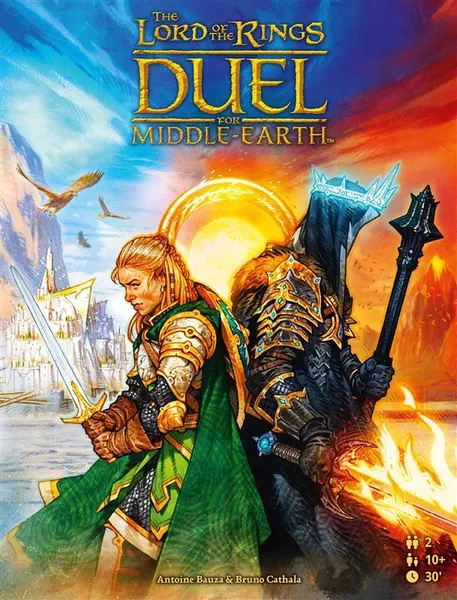
Today we’re diving into The Lord of the Rings: Duel for Middle-Earth. This is a two-player board game from Repos Production that reimagines 7 Wonders: Duel with the rich, fantastical world of The Lord of the Rings. We’re going to break it down – what it is, what’s good, what’s bad, & if you should pick it up. Let’s get into it.
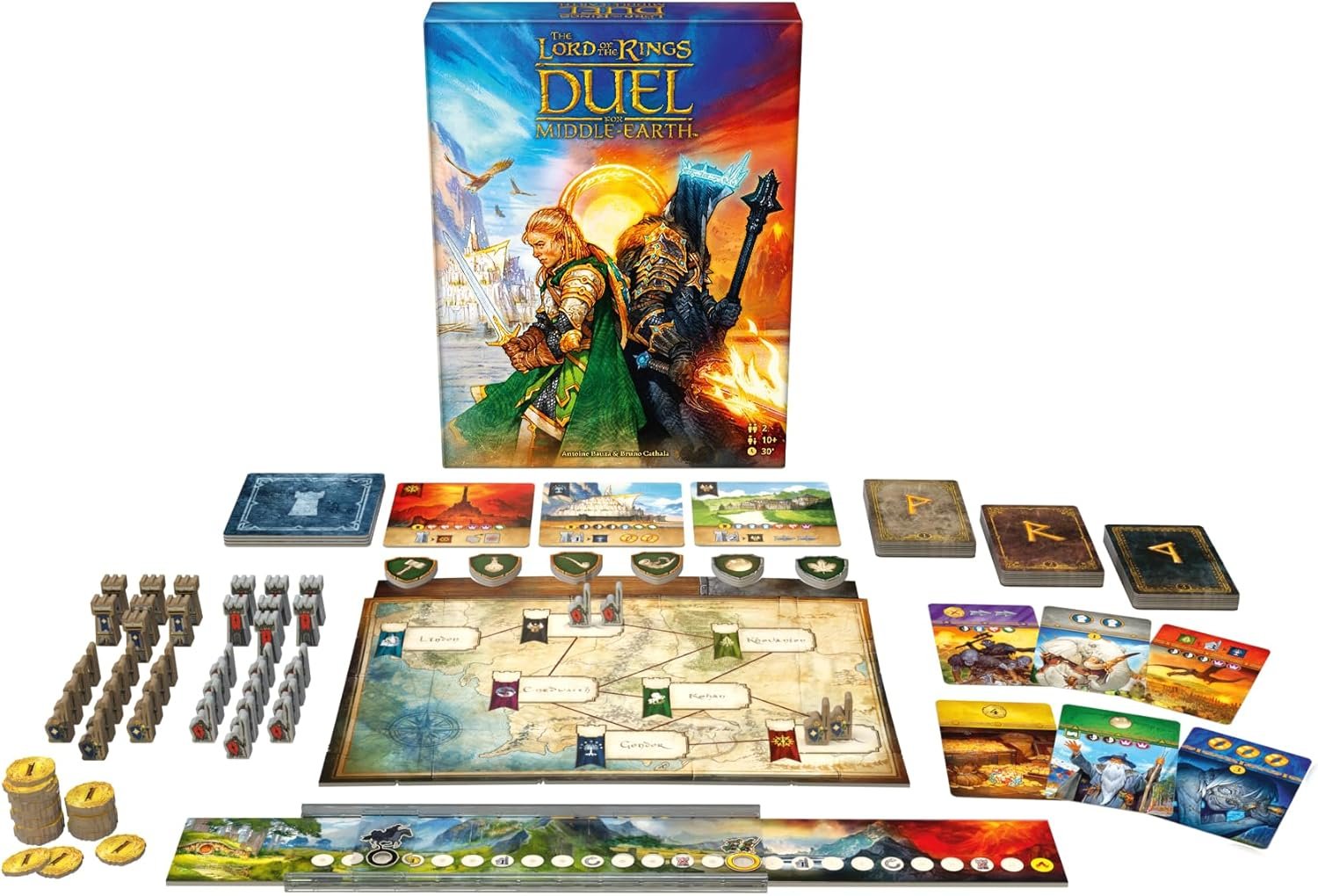
What It Is
The Lord of the Rings: Duel for Middle-Earth is a strategic two-player board game that brings the card-drafting mechanics of 7 Wonders: Duel into the world of J.R.R. Tolkien’s Middle-earth. One player controls the Fellowship, while the other commands Sauron’s forces, & both battle for control over iconic regions like Mordor & Arnor. It’s more than just a re-skin of 7 Wonders: Duel, though—this game introduces new mechanics like a central map of Middle-earth & a Quest of the Ring track that creates thematic depth & enhances gameplay. The game offers three different victory conditions, adding tension & strategic choices that will keep players on their toes.
Check Out These Recent Board Game Sales
- Board Game Sale: Disney Villainous 25% Off!
- Board Game Sale: Marvel: Crisis Protocol Core Set 30% Off!
- Board Game Sale: 7 Wonders Available for 17% Off!
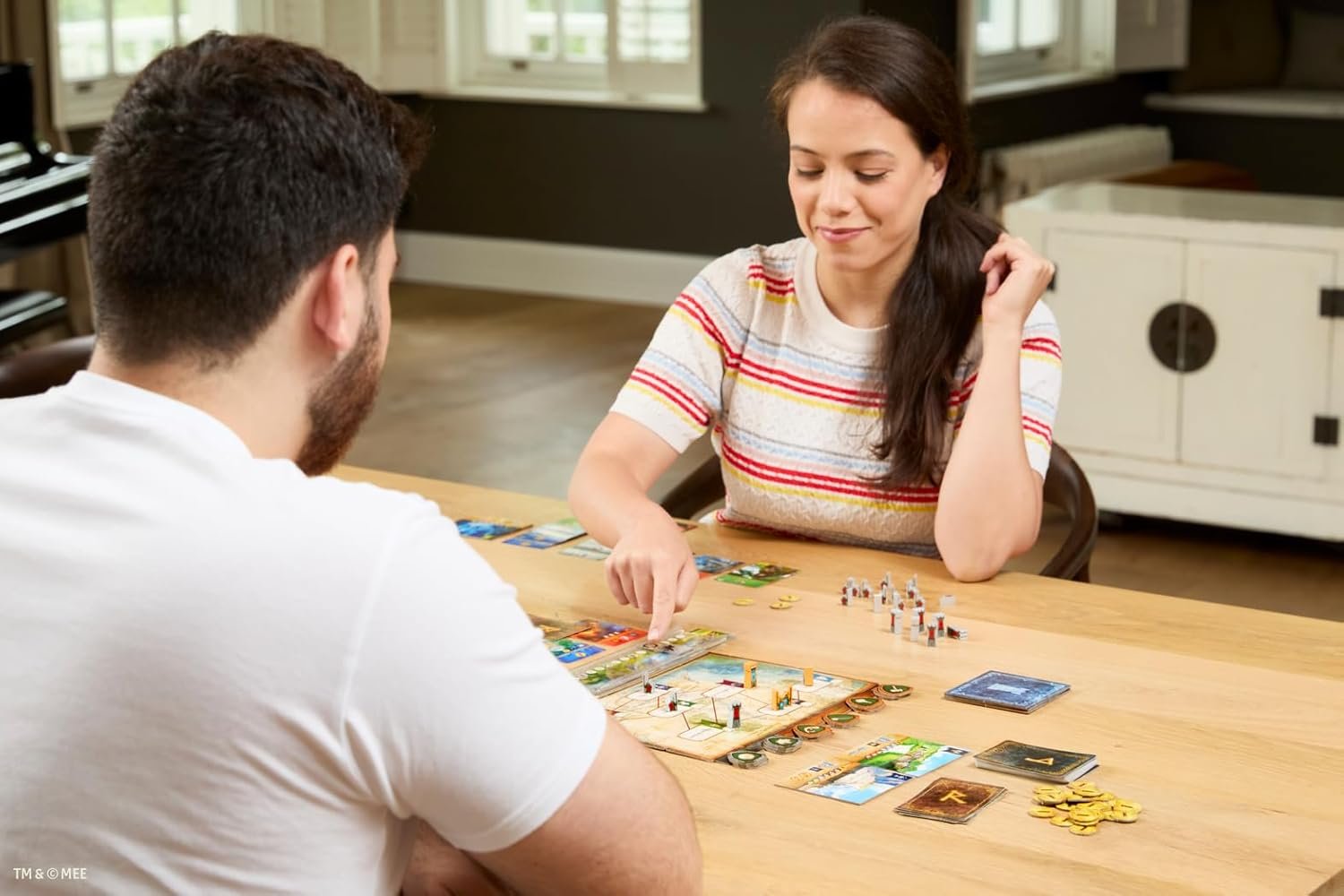
Gameplay Overview
In Lord of the Rings: Duel for Middle-Earth, players are thrust into the iconic world of Middle-earth, where one represents the Fellowship of the Ring while the other embodies the forces of Sauron. This two-player game features strategic battles, alliances, & quests, with each player striving for domination over Middle-earth. At the start, players randomly decide their roles, take corresponding meeples & towers, & set up the game board with a map, alliance tokens, three decks of cards, & coins. The game unfolds over three distinct chapters, with each chapter introducing new challenges & strategies, guided by unique cards.
The game revolves around three winning conditions: completing the Ring’s mission, conquering Middle-earth, or forming alliances. Each player, whether representing Sauron or the Fellowship, takes turns deciding between two main actions: taking a landmark from the board or acquiring a card from the grid. Cards can either be discarded for coins or played in the player’s area to gain abilities & resources. The grid system requires strategic planning, as cards covered by others cannot be accessed, forcing players to carefully manage their choices & unlock pathways to victory.
Players must pay attention to the cost of cards, which varies depending on the chapter, with higher costs & rewards as the game progresses. Some cards have no direct cost but offer abilities that unlock future cards or provide other strategic advantages. As the Fellowship, players begin with three coins, while Sauron starts with two. Sauron always takes the first turn, establishing an initial advantage in planning & resource gathering.
In addition to cards, players can deploy meeples & fortresses on the board, gaining control over regions. Red cards help players place meeples in key areas, with the possibility of eliminating enemy forces when occupying contested regions. Movement cards, on the other hand, allow players to advance their meeples strategically, either traversing multiple regions or targeting opponents to weaken their hold. These tactical maneuvers are crucial for asserting dominance over Middle-earth, either through sheer force or strategic placement.
Purple & green cards offer different types of abilities, with purple cards unlocking devastating effects that often involve forcing opponents to lose resources or meeples. These cards become particularly powerful in the third chapter, where their effects can be game-changing. Green cards allow players to form alliances, granting unique bonuses when matching alliance symbols. Successfully forming alliances can be a critical path to victory, although timing is essential, as opportunities may slip away if players don’t act swiftly.
Another option players have during their turn is acquiring landmarks. These landmarks offer additional strategic advantages but come at a cost, which increases as fortresses are built on the board. Early in the game, landmarks are cheap, but as players fortify their positions, the price rises, adding complexity to resource management. Each landmark also allows players to place fortresses on the board, strengthening their control over key regions & pushing them closer to victory.
The game progresses through its three chapters, with each new phase introducing fresh cards & challenges. Players must adapt their strategies as they navigate shifting opportunities, manage resources, & pursue one of the three victory conditions. The tension builds with each turn as the Fellowship races to destroy the One Ring while Sauron seeks to capture Frodo or conquer Middle-earth through force or alliances.
Overall, Lord of the Rings: Duel for Middle-Earth is a richly strategic two-player game that offers multiple paths to victory & a deep sense of immersion in Tolkien’s world. Whether focusing on military conquest, the race to Mount Doom, or diplomatic alliances, players will find plenty of options for creating their unique strategy. With its balance of card management, area control, & timing, it’s a game that will appeal to fans of both the Lord of the Rings universe & head-to-head tactical games.
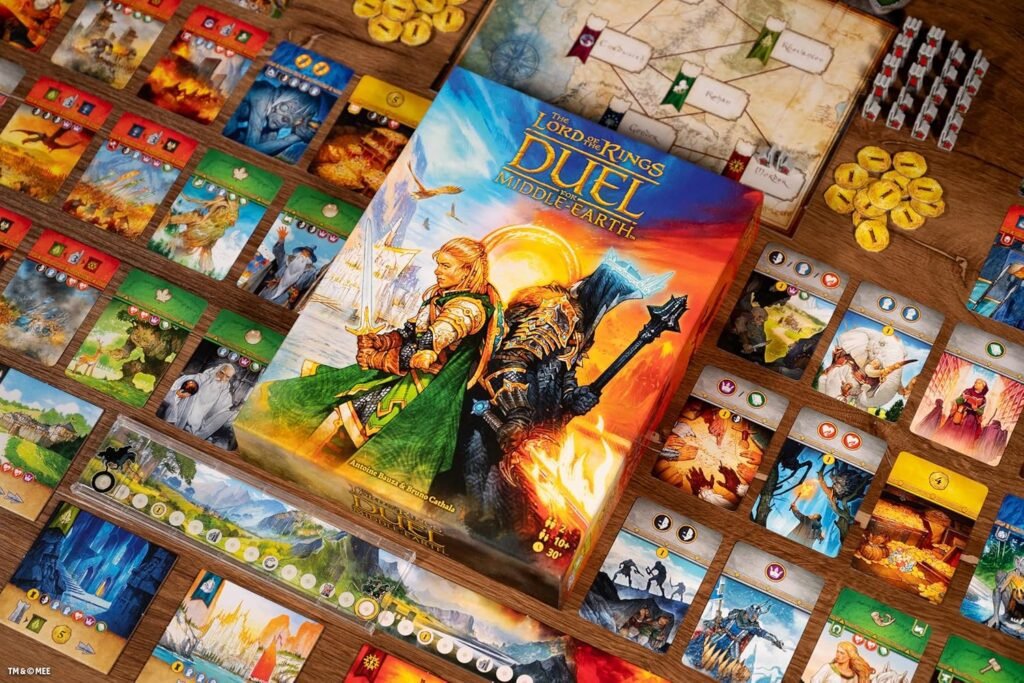
The Components
Visually, the game is stunning, with artwork by Vincent Dutrait that perfectly captures the feel of Middle-earth. The map is detailed, tokens represent different races, & the plastic slider for the Quest track is a neat touch. There are three decks of chapter cards, each representing different phases of the game, & these cards build the draft pyramid just like in 7 Wonders: Duel. In addition, the game features Landmark tiles that replace Wonders, giving players permanent advantages on the map.
Everything about the components feels polished & well thought out, from the detailed unit tokens to the beautiful central board, making the game as much a joy to look at as it is to play.
The Good
One of the game’s standout features is the way it streamlines resource management. Instead of needing to calculate resource costs based on your opponent’s holdings, you simply pay one coin per missing skill symbol. This change speeds up gameplay without sacrificing depth, allowing players to focus more on strategic decisions & less on keeping track of resources. It’s an elegant solution that enhances the flow of the game.
Another huge positive is the central map of Middle-Earth. It adds a whole new layer to the game that wasn’t present in 7 Wonders: Duel. The map creates tense, dynamic conflicts as players vie for control over regions. This, combined with the thematic integration of The Lord of the Rings elements, like the Quest of the Ring track & the race between Frodo & the Nazgûl, really drives home the immersive feel. Every decision feels like it could tip the scales in the battle for Middle-earth.

The Bad
Despite all these great elements, some players might miss the end-game scoring aspect of 7 Wonders: Duel. The shift to immediate victory conditions—whether it’s through the Quest of the Ring, controlling all the regions, or collecting race symbols—creates a more dynamic experience but removes some of the long-term planning that made the original game so appealing. It can feel like the game ends abruptly, which might disappoint those who prefer a slow-burn strategy.
Another drawback is that, for all its thematic immersion, Duel for Middle-Earth still inherits some of the luck-based aspects of card drafting. If you get unlucky with the card flips, it can limit your options in frustrating ways. This is especially noticeable in smaller, head-to-head games where each turn is critical. While there are ways to mitigate bad draws, the random element can occasionally make the game feel
The Verdict
Overall, The Lord of the Rings: Duel for Middle-Earth successfully builds on the foundation of 7 Wonders: Duel while offering a more thematic & immersive experience. The game is fast-paced & strategic, & the addition of the map adds a new layer of depth. Fans of The Lord of the Rings will especially appreciate how well the theme is integrated into the mechanics, making every decision feel tied to the epic struggle between good & evil in Middle-earth. If you’re looking for a tense, two-player game with multiple paths to victory, this is a solid choice.
That said, it won’t be for everyone. The streamlined resource management & focus on immediate victory conditions may not appeal to players who loved the complex strategy & end-game scoring of 7 Wonders: Duel. & while the thematic elements are a huge draw for Lord of the Rings fans, if you’re indifferent to the theme, you might feel that the game leans too heavily on it.
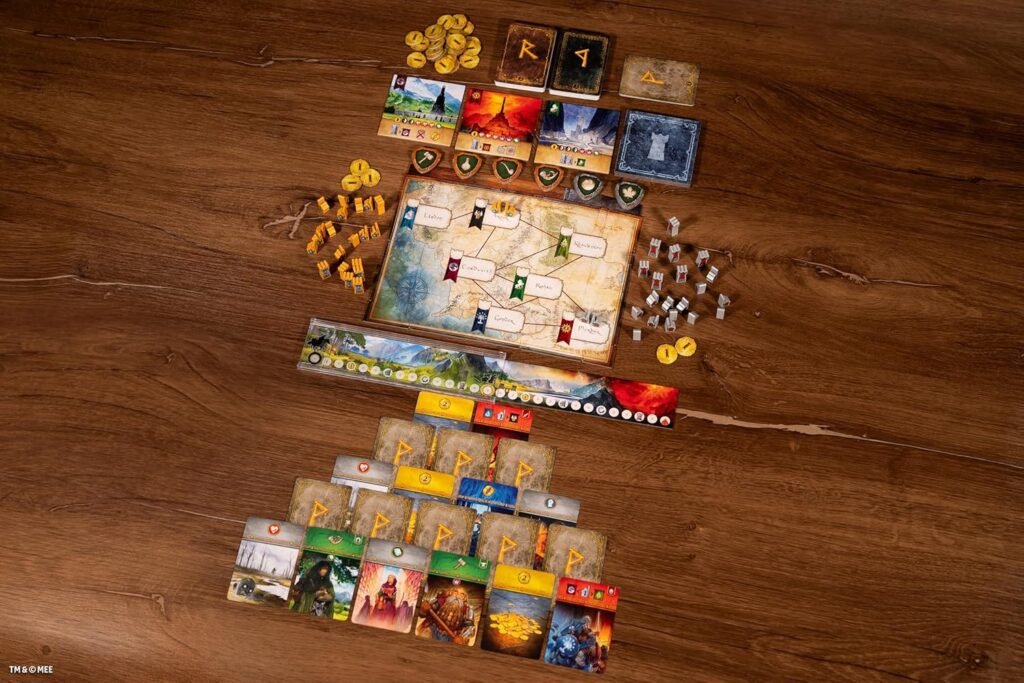
Final Thoughts
The Lord of the Rings: Duel for Middle-Earth really surprised me in all the best ways. I came in expecting a rehash of 7 Wonders: Duel with some Lord of the Rings flair slapped on, but what I found was a game that takes the core elements of 7 Wonders: Duel & builds something that feels fresh, tense, & incredibly thematic. It’s like stepping into the world of Tolkien, but instead of just admiring the scenery, you’re actively battling for control over it. It hooked me right from the setup, & I was totally invested in the outcome every time I played.
The map of Middle-earth was a standout feature for me. It adds a whole new level of strategy that feels natural but also makes you rethink your approach. I’m usually not a fan of military mechanics in games, but the way this one handles combat—placing units, securing regions, & locking down fortresses—was simple enough to follow, yet it added a ton of strategic depth. The constant push & pull between you & your opponent is tense, but it never felt bogged down by overly complicated rules. You’re always making meaningful decisions, & that’s what I loved most.
I also have to give credit to how streamlined the resource management is. In 7 Wonders: Duel, sometimes the resource stuff could get tedious, but here, they’ve simplified it so you can stay focused on the more exciting parts—like outmaneuvering your opponent on the map or making a clutch play on the Quest of the Ring track. The pacing feels snappier, which makes the whole experience more fun & less about crunching numbers.
Speaking of the Quest of the Ring, that was probably my favorite part of the game. The Fellowship racing to Mount Doom while Sauron’s forces are trying to stop them—it’s such a cool way to bring the Lord of the Rings theme into the mechanics. The sense of urgency is real, & it kept me on edge, especially when the Nazgûl started closing in on Frodo & Sam. It makes for some really dramatic moments, & honestly, that’s what makes the game so engaging.
One thing I wasn’t sure about at first was the multiple win conditions. At first, I thought it might be a little too much to keep track of, but after a few games, it felt like a great way to balance the different strategies. You’re never just focused on one thing, & it keeps the game unpredictable. There’s always a sense of, “If I don’t stop them now, they might win next turn.” That kind of tension is what makes a good two-player game, & Duel for Middle-Earth nails it.
Overall, I had a blast with this game. If you’re into 7 Wonders: Duel, you’ll probably appreciate how this one changes things up. & if you’re a Lord of the Rings fan like me, it’s a no-brainer. It’s not just a reskin—it’s a game that captures the spirit of Middle-earth while still being a smart, tactical battle of wits. I can see this hitting the table a lot, whether I’m in the mood for a strategic challenge or just want to dive back into Tolkien’s world.
Purchase Options

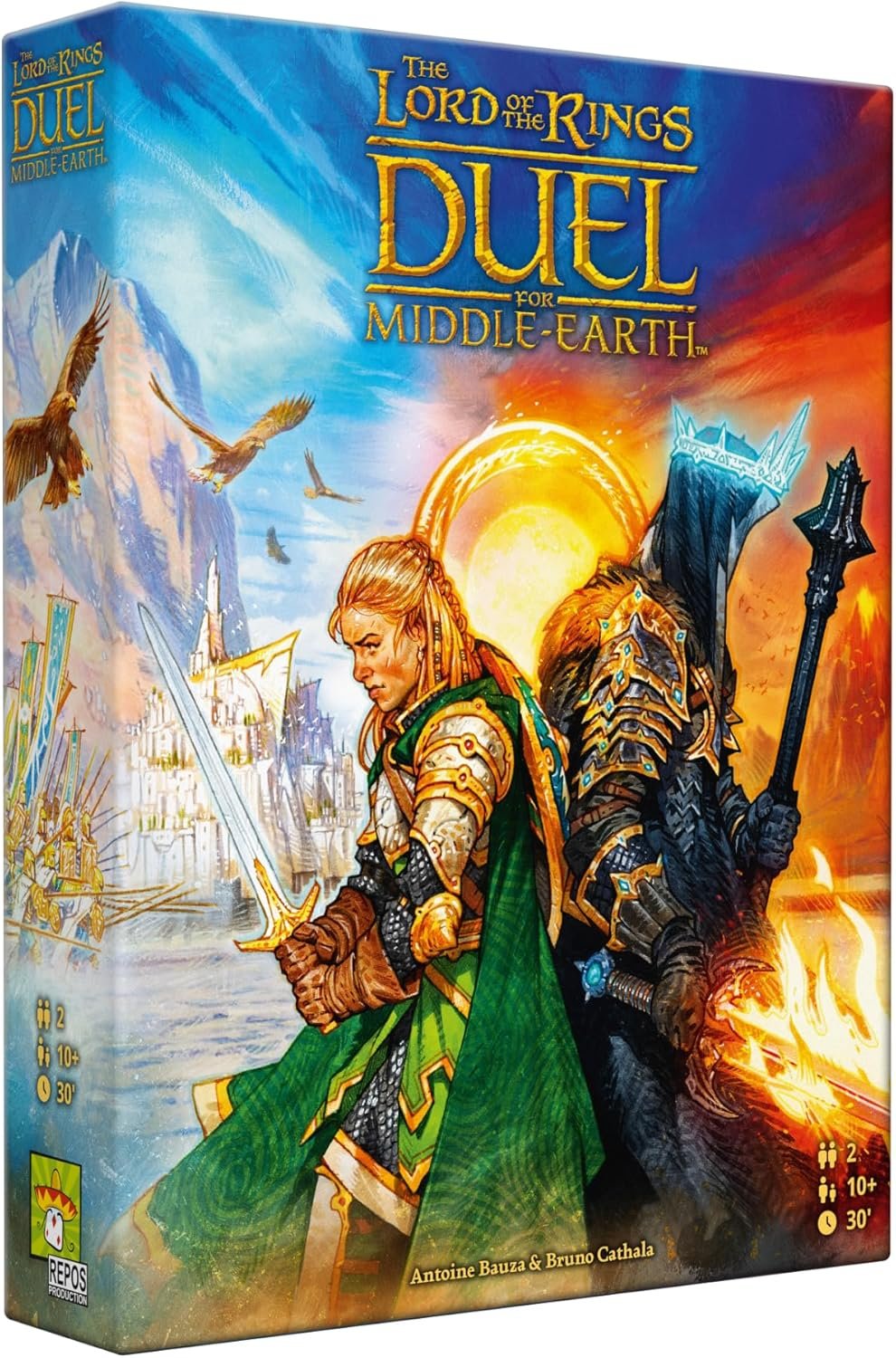
At no extra cost to you, The Board Game Site may receive revenue from affiliate and advertising partnerships for sharing this content and from purchases through links.








